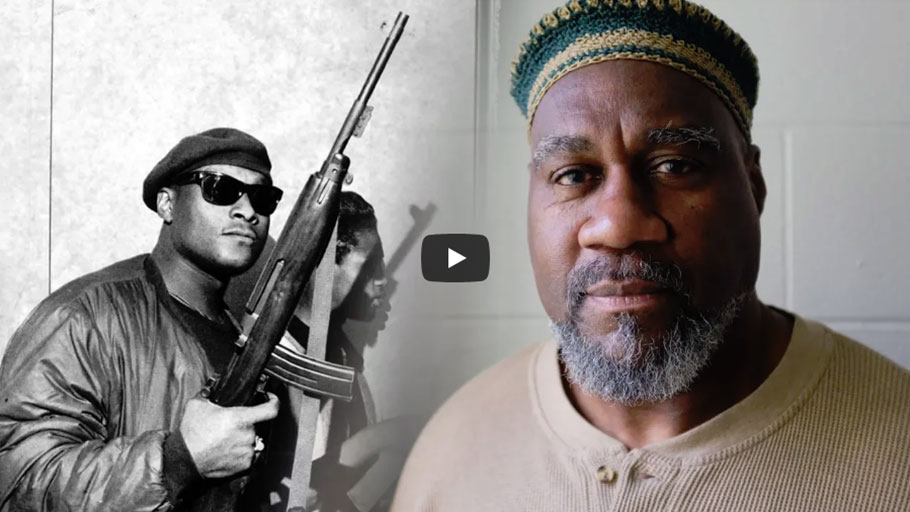Over two years, Ed Pilkington has interviewed eight people imprisoned since the 1970s black liberation struggle that rocked the US. As they near 50 years inside, will America’s black radicals ever be freed?
By Ed Pilkington with video by Tom Silverstone, The Guardian —
Antoinette Russell vividly recalls the first time she was led to believe she would finally meet her father as a free man. He called her up on a prison phone, his voice shaking with excitement, and told her: “I’m coming home!”
That was 17 years ago. Since then, every two years, she’s been put through the same agonizing drill. “He’d call saying the same thing: ‘I’m coming home,’” she said, speaking at her home in Montgomery, Alabama.
“It got to the point where I said, ‘Daddy, I don’t want to hear that any more. I get my hopes up thinking you’re going to be released and then you’re not. It kills me every time.’”
A thousand miles away in Deer Park, Long Island, Diane Piagentini is trapped in exactly the same traumatic cycle, connected to the same man. “Every two years the Band-Aid gets ripped off your heart and you have to recall everything that happened and play it over and over again,” she said.
The unbearable pain felt by these two women may bear comparison, but there the similarities end: they have nothing in common when it comes to their desires about what should happen to him.
Russell hopes her father will be given his freedom. Piagentini prays he rots in his cell until the end of time.
“He needs to stay in prison for the rest of his life. When you commit a heinous crime like that, you deserve only the death penalty.”
The focus of both women’s attention is Antoinette Russell’s father, Jalil Muntaqim, who is known in maximum security prison by his birth name, Anthony Bottom, and ID number, 77A4283.
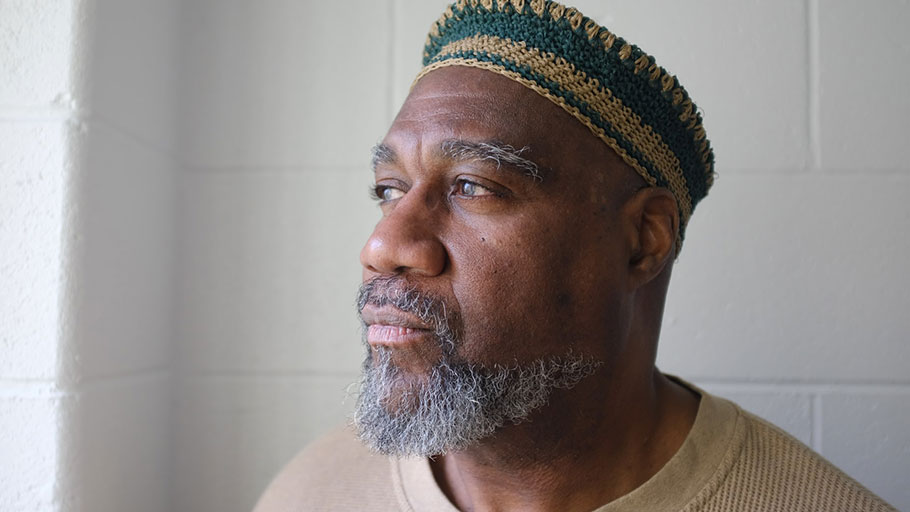
Jalil Muntaqim, who has spent the last 47 years in prison. Photograph: Tom Silverstone for the Guardian
A former member of the Black Panther party and its underground wing the Black Liberation Army, he has spent almost 47 years in prison for his part in the 1971 murders of two New York city police officers. One of those officers was Joseph Piagentini, Diane’s husband.
Muntaqim is one of 19 black radicals, including two women, who are still imprisoned 40 or more years after they were arrested for violent acts related to the black liberation struggle. Next year the longest-serving inmate, Romaine “Chip” Fitzgerald, will have been locked up for half a century. The oldest, Sundiata Acoli, is 81.
Since 2000, a further 10 black radicals have succumbed to ill health and died in prison.
The 19 incarcerated militants were all part of the 1970s black revolutionary movement. They fought for black power, they were convicted of killing for it – though many profess their innocence – and today they are still imprisoned for it.
As they grow older, and the length of their incarceration ticks up, the ethical battle over what to do with these men and women grows ever more intense. Just last week there was a stunning development, reported here for the first time: Robert Seth Hayes, like Muntaqim a former member of the Black Panthers and Black Liberation Army was released last Tuesday, aged 69, from the same New York maximum security prison.
Hayes had been imprisoned for 45 years for the murder of a New York city transit officer, Sidney Thompson, during an encounter at a Bronx station in 1973. He was convicted and sentenced to 25 years to life.
He became eligible for parole in 1998, but every two years he was told the same thing: despite a clean prison record, he remained a threat to society in the eyes of the parole board. It was only on his 11th attempt, 20 years later and with his health rapidly failing, that he convinced them he was worthy of rehabilitation.
Hayes’ freedom further ups the ante, forcing authorities in New York and across the country to consider fundamental questions: is there such a thing as rehabilitation for those found guilty of killing police officers in the cause of black revolution? Do they have to renounce their politics to merit release? Or is the US criminal justice system singling them out for especially harsh treatment and never-ending captivity as political prisoners, as the men and women themselves contend?
Over the past two years I have interviewed eight black liberationists who have all experienced prolonged prison time.Through prison visits, letters and emails, the militants told surprisingly similar stories of how they had coped spending almost their entire adult lives in cells and of the long road to an elusive freedom. Six are among the 19 who remain incarcerated to this day.
One of the most striking aspects of their stories is the enduring passion they all express for the cause of black liberation. Their belief in the nobility of the struggle against injustice is undiluted and undulled.
Take Jalil Muntaqim, 66. Under the terms of his sentence for double homicide he has been entitled to be considered for parole every two years since 2002. This August the cycle comes round again: he will go before a parole board for the ninth time to plead for his release.
He will tell the panel of his remorse towards the families of the police officers who died. He will tell them of the remorse he feels too towards his own family, whom he has deprived of his company for 46 years.
But he will not renounce his politics.
As he put it during a two-hour interview in Sullivan correctional facility in upstate New York: “If you understand the oppression that black people have suffered in this country, no one should have any regrets for having been identified as a revolutionary. I have no regrets about that.”
The Black Panthers, who officially ceased to exist in 1982, seem to have become posthumously fashionable in the past couple of years. The opening sequence of the smash-hit movie Black Panther is set in a public basketball court in downtown Oakland, in a strong allusion to the foundation of the party in the same location in 1966. Beyoncé stunned the nation with her 2016 Super Bowl homage replete with black leather jackets, berets and raised fists.
Behind this veneer of popular flirtation with the Panthers, there is very little public discussion about the 1970s upheaval and its aftermath. Popular understanding is scanty about how the Panthers spread from its Oakland beginnings, spawning 70 chapters across the States; how it openly challenged the brutality shown by police forces towards African Americans in the inner cities; how it developed a sophisticated social program that included food banks and even elementary schools; and how in turn it provoked a furious response from the federal government and FBI that led to numerous gunfights, raids, deep surveillance, dirty tricks and the eventual disbandment of the party in 1982. Even less is known about the many Panther activists who were imprisoned.
In short, the Black Panther uniform in black leather might now be de rigueur, but there is precious little interest shown in the prison uniforms of the former Panthers behind bars.
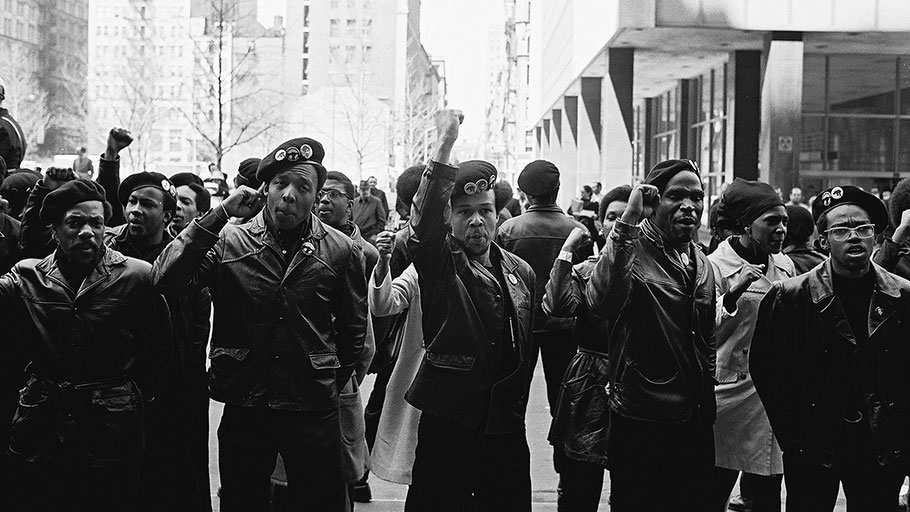
Black Panthers protest outside the New York City courthouse in 1969. Photograph: David Fenton/Getty Images
The journey that led me to dive into the lives of incarcerated former Black Panthers began in 2015 with Albert Woodfox, a member of the so-called Angola Three who had the distinction at that time of being America’s longest-standing solitary confinement prisoner. He had been locked up in a cell alone almost without a break for 43 years.
Together with a fellow inmate, Herman Wallace, Woodfox had set up a branch of the Black Panthers in Angola, the notorious maximum-security penitentiary in Louisiana built upon the grounds of an old cotton-picking plantation. Its name was derived from the African country where the plantation owners obtained their slaves.
When Woodfox was sent to Angola in 1971 for robbery, the prison was entirely segregated, with a wing for white prisoners and a separate wing for African American prisoners. The guards were exclusively white.
In one of the sharpest examples of the unbroken thread between slavery and modern mass incarceration, black prisoners were used as a cheap supply of farm labor. Every day the black inmates were assembled into chain gangs, taken into the fields around the penitentiary – the same fields that had belonged to the plantation – and made to work under the blazing sun.
Picking cotton.
Woodfox and Wallace began organizing other black inmates through the Black Panther chapter to protest against this modern form of slavery. It didn’t sit well with the prison authorities.
A year later, they were both accused of murdering a prison guard named Brent Miller, who had been stabbed to death amid a prison riot. Considerable forensic evidence was gathered at the murder scene, but none of it matched either of them, including a bloody fingerprint found on a wall.
Yet they were still found guilty by all-white juries and sentenced to life without parole. Immediately upon sentencing, Woodfox and Wallace were placed in isolation cells, there to remain for the next four decades.
It’s like the atmosphere is pressing down on me, closing in all around me — Albert Woodfox on solitary confinement
Comments made by top Angola officials over the years made plain the reason for such exceptionally harsh treatment. The then warden of Angola, Burl Cain, said in 1995 that he wanted Woodfox held solitarily because he was “still trying to practice Black Pantherism”. Cain added that he didn’t want the prisoner fraternizing with others “because he would organize the young new inmates”.
In November 2015, shortly before Woodfox was finally allowed to walk a free man aged 69, he wrote to me. He described in his letter his experiences of living for 43 years in a 6ft-by-9ft box containing only a concrete bunk, toilet and sink, and with a slot in the metal door for food to be passed.
He wrote about how he survived regular bouts of claustrophobia inside his cell: “For me it’s a matter of recognizing when an attack is coming. I become very aware of space and time. My clothes start to feel very constraining. I start to sweat and it’s hard to breathe. It’s like the atmosphere is pressing down on me, closing in all around me.”
While Woodfox and Wallace were sweating out the years in solitary in Angola, thousands of other young African Americans were being drawn to the Black Panther party in Oakland, Los Angeles, Chicago, New York and across the US. Though the party was set up by two men, Huey Newton and Bobby Seale, and had a military aesthetic that could be described as macho, women also came to occupy senior positions within it.
They included Afeni Shakur, mother of the rapper Tupac Shakur; Elaine Brown, who rose to be chairman of the party after Newton fled to Cuba; and Assata Shakur, AKA Joanne Chesimard, a leader of the Black Liberation Army who also fled to Cuba, where she lives in exile today, still listed by the FBI as one of its most wanted terrorists.
The movement, in contrast to its violent reputation, devoted much of its time to community work. It provided free breakfasts for children in low-income black neighborhoods, set up schools and medical centers treating the uninsured, and published its own newspaper, the Black Panther, selling for 10 cents with a peak weekly circulation of 250,000.
In contrast to the measured tone of Martin Luther King’s civil rights movement, the Panthers saw themselves as being aligned with international revolutionary groups in Angola, Mozambique or Vietnam. New recruits, known as PITs, for “Panthers-in-Training”, were made to study Mao’s “little red book” and The Wretched of the Earth by Frantz Fanon.

Members of the Black Panther party stand behind tables ready to distribute free clothing to the public in New Haven, Connecticut, 1969. Photograph: David Fenton/Getty Images
On October 1966, Newton crystallized the goals of the party into a 10-point program. It was a cross between a call for an end to police brutality not dissimilar to today’s Black Lives Matter, criminal justice reform that would sit comfortably with the American Civil Liberties Union, and a demand for full employment, decent housing and good education that might have come from the lips of Bernie Sanders.
On top of such relatively mainstream demands, it threw in a strong dash of black militancy quite in contrast to King’s approach or to the established progressive politics of today. “We want an end to the robbery by the capitalist of our Black Community,” read point number three, going on to demand reparations for slavery equivalent to 40 acres and two mules – a nod to the as yet unfulfilled promise made by Gen William Sherman to freed slaves at the end of the civil war.
Then there was the emphasis on militarism and armed struggle. Even the structure of the organization was a provocation, setting the party up as a state within a state.
As Mumia Abu-Jamal, a former Black Panther who has been incarcerated for 37 years for the murder of a Philadelphia police officer, puts it: “The Black Panther party performed in the role of a shadow state – with its Ministries, its uniformed personnel, and its soldiers in sharp opposition to the US government.”
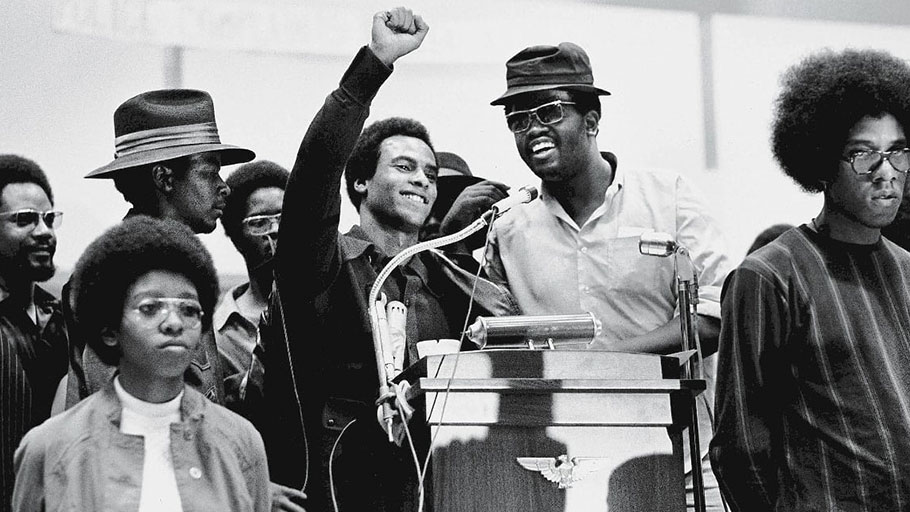
Huey Newton Speaks At Revolutionary People’s Party Constitutional Conventionin 1970. Photograph: David Fenton/Getty Images
One of the party’s earliest activities was “cop watch”, in which members monitored police activities on the streets of Oakland at a time when police assaults on black people were rampant. It’s hard to imagine this happening today, but where officers were seen to stop and search African American youths, Black Panthers would approach them and stand there as observers, pointedly brandishing handguns at their hips.
Newton had studied California’s gun laws and knew that carrying loaded weapons openly in public was legal in the late 1960s. State legislators responded in 1967 by banning “open carry”, and to mark the occasion more than 20 Panthers entered the state capitol during the debate, waving guns.
The threat of armed insurrection by black revolutionaries inspired a powerful retaliation from the US government. The then director of the FBI, J Edgar Hoover, vowed to crush the Black Panther party, which he called “the greatest threat to internal security of the country”.
The surveillance program Cointelpro placed its spotlight on the Panthers, and vast FBI resources were mobilized against them. Before long, the party was riddled with informants and agent provocateurs, spreading disinformation and sewing dissent within the ranks.
Violent clashes with police became frequent: “shoot outs”, law enforcement and the media called them. “Shoot-ins”, said the Panthers, insisting the confrontations were instigated by the authorities as part of Cointelpro dirty tricks.
The Panthers themselves estimated that between 1968 and 1970 there were 28 armed clashes with local police or FBI agents, in which 19 of their own were killed. In return, police unions hold the Black Liberation Army, the clandestine offshoot of the party formed in 1970, responsible for the murders of at least 13 police officers.
It was into this environment that Jalil Muntaqim, then going by the name Anthony Bottom, threw himself when he was 15. He was an unlikely candidate for a black revolutionary, coming from a comfortable home in San Jose with working parents and a swimming pool in the yard.
His mother used to teach the children African dance and emphasize their African descent. Muntaqim took a close interest in King and the civil rights movement, but he was soon looking for a more radical stance. A friend at school had become a Black Panther and he was drawn in.
“The idea that black men armed and prepared can fight for the rights of black people was exciting, intriguing. It went beyond the civil rights movement of Dr King. It was the difference between Dr King and Malcolm X, who put our struggle into an international perspective,” he told me.
Muntaqim began by selling the Black Panther newspaper and helping with free-food programs. From there he was promoted to security details for high-profile leaders visiting Oakland.
The idea that black men armed and prepared can fight for the rights of black people was exciting, intriguing — Jalil Muntaqim on joining the Panthers at 15
In 1970, the Black Liberation Army (BLA) was formed as the armed phalanx of the movement. Between then and the formal disbanding of the Black Panther party in 1982, it carried out a wave of bank robberies, bombings, prison breakouts and shootings of police officers.
Muntaqim signed up when he was 18 and went clandestine. “I continued to have a public life as a social worker in the California unemployment department,” he explained in the interview. “But there was another side to my life – being underground with the Black Liberation Army.”
On 21 May 1971, two New York police officers, Joseph Piagentini, who was white, and Waverly Jones, who was black, were on foot patrol in 159th Street in Harlem. They had been called to what they thought was a domestic dispute.
Diane Piagentini described Joseph as “a great husband and father who loved our two young daughters. He was tall, almost six feet, with dark hair, dark eyes. He had a great smile, a little crooked, and a cleft in his chin. He was the love of my life. I loved him from the minute I saw him.”
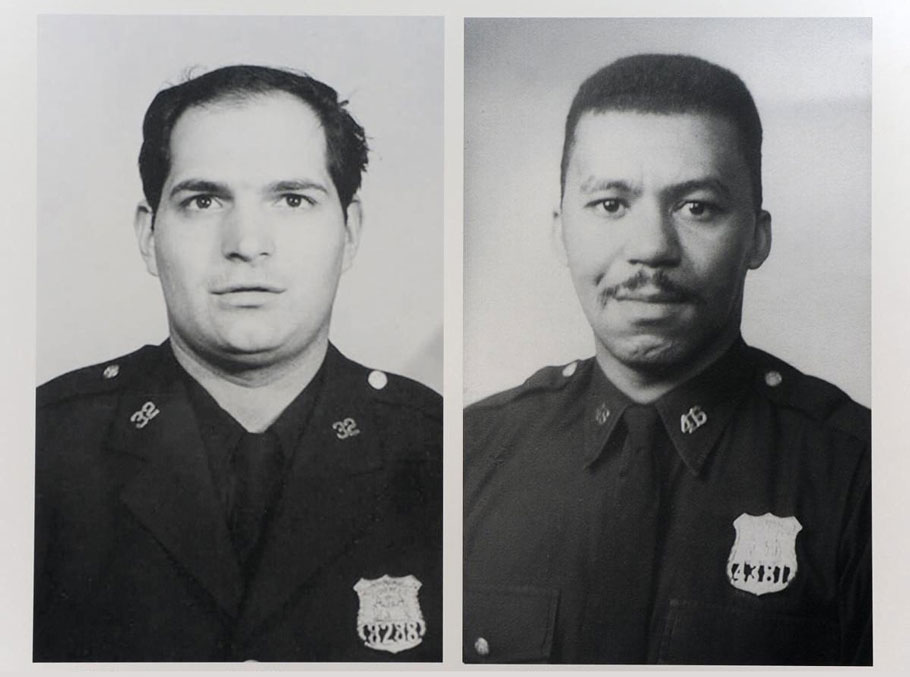
The NYPD officers Joseph Piagentini, left, and Waverly Jones, who were murdered by Herman Bell and others in Harlem in 1971. Photograph: New York State Senate
She recalled how the news was broken to her that night. “I had made him pasta fagioli, keeping it warm as I waited for him to come home. There was a knock on the door. I looked out and it was raining. I could see the police lights going around and around. No sirens, just lights. It was like you were in a dream.”
Joseph Piagentini and Jones had been returning to their police cruiser at about 10pm when they were set upon by three armed men from behind. Jones died instantly from a shot to the back of the head; Piagentini was shot 13 times, according to prosecutors.
Within days, three members of the BLA – Muntaqim, Herman Bell and Albert “Nuh” Washington – were arrested. Muntaqim and Bell were both sentenced to 25 years to life; Washington died in prison in 2000.
Three months ago, a very rare event occurred. Herman Bell, now 70, was released. It was his eighth time before the panel, after 45 years behind bars.
Bell had impressed the parole board as someone who over almost half a century had become a rule-abiding inmate with genuine feelings of remorse about the killings. Part of the board’s thinking was that when they interrogated Bell in March, he expressed his revulsion for what he did in 1971.
“There was nothing political about the act, as much as I thought at the time. It was murder and horribly wrong,” Bell told them.
The parole board’s decision kicked up a storm with local police unions, tabloid newspapers and elected politicians. The New York Patrolmen’s Benevolent Association said it was “disgusted, offended and extremely angry” and called Bell a “domestic terrorist”.
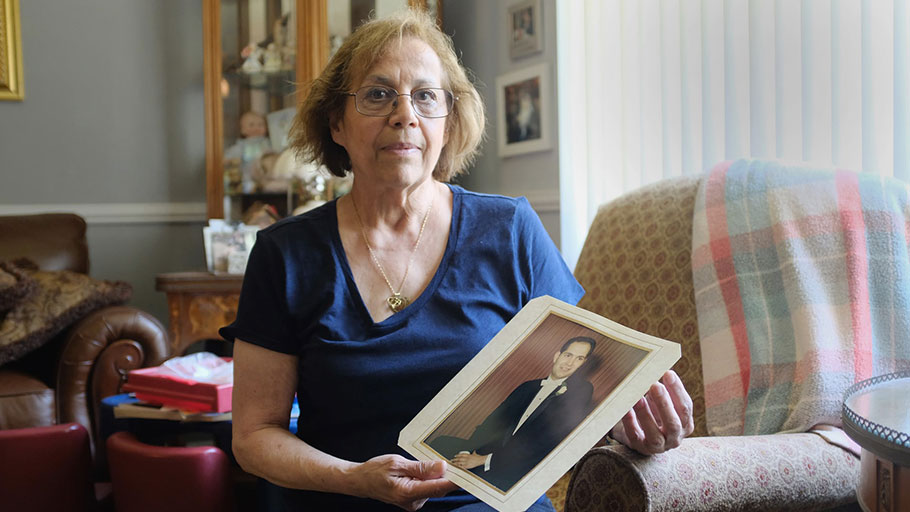
Diane Piagentini at home. Photograph: The Guardian
Such a backlash to the parole of his co-defendant underlines the huge challenge facing Muntaqim as he goes before the parole board in August.
In his favor is the clean prison record he has held for years. So too is the mellowing of his character since the heady days of his black liberationist activism as a teenager.
“I’ve matured. I now take the ‘r’ off the word and make it ‘evolutionary’. Revolution for me is the evolutionary process of building a higher level of consciousness in society at large. I’m an evolutionary revolutionary.”
He also said that his views on armed struggle had evolved. He said the priority now was not insurrection but to build a “mass popular movement. I prefer to say we are armed with ideas, and compassion and love for our people.”
Like most of the 19 remaining black radicals behind bars, he sees himself as a political prisoner, arguing that his participation with the Black Panthers was undertaken for no personal self-aggrandizement or profit. In 1998, he formed the Jericho movement, which campaigns for those it calls “political prisoners and prisoners of war”.
“My engagement in the struggle was self-sacrifice because of my love of my people and humanity. Because of that I was targeted by the government and that indicates that my incarceration is of a political nature.”
Muntaqim’s conflict – his burning desire for freedom rubbing against his determination not to renounce his politics which he sees as noble – is shared by most of the 19 remaining black radicals behind bars.
Of the 19, all but three were convicted of murdering police or other uniformed officers. Many profess their innocence, and most argue they have been selectively subjected to the full wrath of the American state.
How does their treatment compare with that of other convicted murderers who killed officers in the course of committing common crimes such as robberies? Firm comparisons are impossible given the devolved nature of America’s criminal justice system. As the Sentencing Project points out, “the 50 states vary on sentencing. As there are relatively few political cases, it’s hard to form any concrete conclusions.”
International comparisons, however, are instructive. Compared with the penal treatment of armed revolutionaries who were carrying out violent acts in Europe in the 1970s, the US appears far less open to concepts of rehabilitation.
Take the Baader-Meinhof Gang in then West Germany, the far-left militant group founded in 1970 also known as the Red Army Faction. One of its militants, Irmgard Möller, was arrested in 1972 for bombings that wounded several police officers and killed three soldiers – she was released in 1995. Brigitte Mohnhaupt was captured in 1982 and sentenced to five life terms for her role in numerous assassinations – she too was released in 2007 after 24 years in prison and since then has lived anonymously with no further engagement with law enforcement.
Criminal justice reformers argue the long sentences of the black radicals have to be seen in the context of America’s uniquely severe approach to punishment, especially for black men. The US has 5% of the world’s population, but 25% of world’s prisoners, with more than 2 million in confinement. Black people in America are almost six times as likely to be imprisoned per capita than white people. In 2016, according to the Pew Research Center, black people represented 12% of the US adult population but 33% of the prison population. White people, by contrast, accounted for 64% of adults but 30% of prisoners.
The vast pool of captive Americans is also ageing fast. By 2030, people aged 50 or older are projected to account for a third of the US incarcerated population.
“The issue is one of justice and rehabilitation,” said Robert Boyle, who has represented six former Black Panthers in parole proceedings, including Herman Bell’s. He declined to discuss the Bell case but said in general terms: “It’s a discussion that we need to have in this country and around the world. Is the only justice for the murder of a police officer or other serious crime that the person is executed or dies in jail, even when they are no longer any danger to the public?”
The writer and activist Angela Davis, who was herself branded by President Richard Nixon a “dangerous terrorist” after she was accused but later acquitted of involvement in a courtroom kidnapping, told me that the remaining imprisoned black liberationists were caught in a double-bind. Either they repent of crimes they may not have committed, or they die in their cells.
“Many of the people in prison, I believe, are not actually guilty of the charges. They would have to confess to engaging in acts which they hadn’t engaged in.”
Davis said that there was also pressure on the militants to betray their politics. “They have to denounce a party that was the forerunner of movements like Black Lives Matter today.”
When Jalil Muntaqim stands before the parole board in a few days’ time, he is almost certain to be asked what happened on the night of 21 May 1971. When I met him in prison, I asked the same question.
He still believes that his case was unjustly handled. He has obtained documents under freedom of information laws that show that Nixon and Hoover took close personal interest in the hunt for the killers of the New York police officers, which they codenamed “Newkill”, short for New York killings. That unusual collaboration between the White House, FBI and local detectives had not been disclosed to Muntaqim’s defense team at trial as it should have been.
Muntaqim also believes the documents point to glaring discrepancies in evidence put to the jury about the gun used in the murders.
Is he saying that there was a desire at highest level to pin the killings of Piagentini and Jones on him?
“I am saying that emphatically. This case was a frame-up. It is important that people understand we did not receive a fair trial. Nixon and the FBI intended to make sure Black Panther party members were convicted of this crime.”
Despite the injustices he insists he suffered, Muntaqim is not making a claim of innocence. Since 2006, he has been telling the parole board every two years that he takes responsibility for the shootings and that “I deeply regret my involvement in these tragic deaths”.
He said to us: “I have admitted to committing this act and have accepted responsibility. I have also expressed remorse for the loss of life. I understand the devastation for anyone losing their loved one. Both families – the Jones family and the Piagentini – have lost somebody very precious to them.”
Were he to be allowed to walk free, he said, his focus would be “to re-establish my relationship with my family. I haven’t spent a single day with my daughter on the streets. I’m a great-grandfather and I haven’t spent any time with any of my kids.”
He had a direct message for Diane Piagentini: “I understand her anguish. She lost the love of her life and her children’s father. That’s devastating. I understand her hurt and pain, I truly do.”
Piagentini is having none of that. Muntaqim, she said, “has never admitted to killing my husband. He has never shown any remorse. All he is trying to do is get out of prison.”
Of the death of her husband almost 47 years ago, she said: “The hurt never goes away. To know that he will never come home again – I don’t feel it any less. He didn’t want to leave me that night, and therefore he has never left me.”
She scoffed at the idea that Muntaqim and his peers were political prisoners. “These men are not political prisoners, that is a figment of their imagination. They did not have to do what they did to be in politics. There is no war. This was murder. They are murderers.”

Antoinette Russell. Photograph: Tom Silverstone for the Guardian
Down in Alabama, Antoinette Russell cannot help but be on tenterhooks before her father’s imminent parole hearing, despite her best efforts to remain detached from the process. She was born as his only child six months after his arrest. She guesses she has only seen him physically about 10 times in her life, only ever behind electrified barbed-wire fences.
She looks back on her life and wonders how different it might have been had he not joined the Panthers. “Growing up without my dad had a lot of ups and downs, more downs than ups,” she said.
“When I was younger, I was really upset with my dad. I felt he put the cause before me, before his family.”
She’s forgiven him over the years. But the desire to have him home has only grown.
“Aren’t prisons there to rehabilitate?” she asked with a tearful laugh. “He’s been there for 46 years. How much time does it take to be rehabilitated?”

